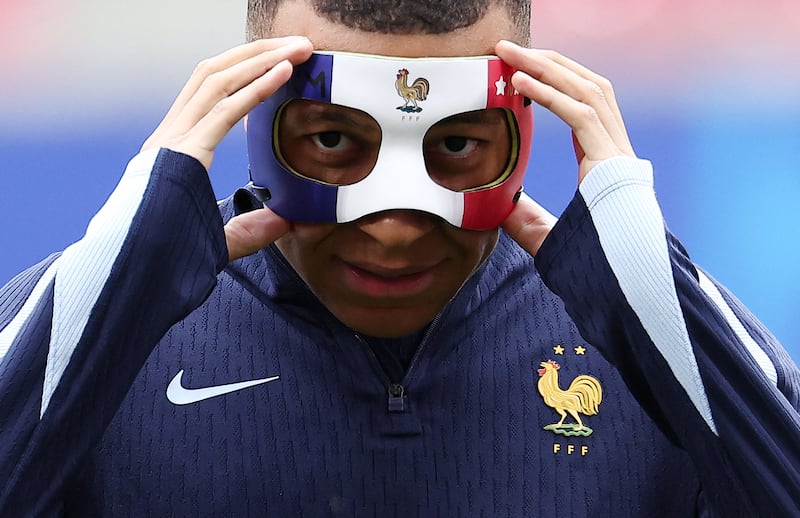“Leipzig is united by football,” according to the Uefa billboards speckled across a city that entered the imagination after reading Keith Duggan’s feature around the Netherlands versus Serbia match at the 2006 World Cup.
Tournament football took a back seat when Keith visited Johann Sebastian Bach’s tomb in Thomaskirche and the former Stasi headquarters.
Having seen The Lives of Others, a hypnotic film set in 1984 about secret police Captain Gerd Wiesler bugging the homes of Berlin creatives, it was fascinating to read this reappraisal of east German society 17 years after the wall came down.
Another 18 years later, I retraced our modern-day Washington correspondent’s steps before covering Portugal versus Czechia.
Germany fondly remembers ‘06, calling it Sommermärchen; a moment in time when they could unashamedly gather and sing in their cobbled squares as Jürgen Klinsmann led a young side to the semi-final in Dortmund. Remember the late Italian goals by Fabio Grosso and Alessandro Del Piero that sent the Azzurri into a final against France and Zinedine Zidane.
[ Euro 2024: Can Germany repeat the glorious football parties of yesteryear?Opens in new window ]
Back then, young Germans needed to embrace the present, and not the threat of war in Europe or memories about the night of December 3rd 1943 when the RAF dropped 1,400 tons of fire-bombs on Leipzig.
In 2024, like 2006, traces of a horrid post-war past are housed at the “round corner” building in Dittrichring, renamed the Memorial Museum in 1990.
So Bach took a back seat as delving into East Germany’s secret police files, with its rebuilt bunker cell, became a meditative hour well spent.
The psychological torture the Staatssicherheit visited upon its own citizens, by intimidating neighbours into informing on each other, was a sophisticated yet equally simplistic means of controlling a populace.
Hidden cameras at public gatherings, like church , produced thousands of pictures of suspected resistance cells, seeping fear and misinformation into the city’s daily existence.
“A revolution is not a thing that exists,” read one Stasi memo, “it is the act by which one part of the population coveys its will on the other part.”
From the Kilmainham yard where James Connolly was propped up and gunned down in 1916 to Al Capone’s cell on Alcatraz in the San Francisco bay, prison museums have always piqued my interest.
Simona provides a welcoming smile on entry. An Italian living in Leipzig since 1995, she notes the changing vibe of a place that felt so “full of hope and potential” when she first arrived from Milan.
“Many ‘east Germans’ feel colonised,” she says, “as senior positions in universities and banks are taken by people who have moved to Leipzig from the west of Germany.”
Walking through the chillingly preserved Stasi offices, we find a picture of Captain Wiesler, “teaching the application of operational psychology for interrogation.” Those suspected of anti-communist behaviour were not always arrested and guillotined, which did happen until 1968, rather their work and family life was inexplicably disrupted until they slowly went insane.
“This was an abuse of psychology,” wrote Joche Girke, a lieutenant colonel and head of the psychology department at the Stasi university near Potsdam.
When Girke expressed an ambition to become a documentary filmmaker, during compulsory military training, “a civilian clad gentleman smiled very darkly” and suggested a placement in the Stasi guard regiment. Three years later, when he tried to branch into radio production, another “civilian clad gentleman smiled darkly and said, ‘If you’re already with us, don’t you want to stay?’”

That’s how intellectuals were corrupted. To ignore the past is a sure method of repeating history, as France captain Kylian Mbappé highlighted last week, when asked about Europe’s latest lurch towards far-right governments.
“We are a generation that can make a difference,” said Mbappé. “We see the extremes are knocking on the door of power and we have the opportunity to shape our country’s future.
“The game tomorrow is very important,” he added, “but this situation is even more important than the game.”
The difference between 2006 and 2024, in Leipzig anyway, is that the consequences of war are no longer a fading memory. The battle front has returned to eastern Europe, as Ukraine defends itself from the Russian invasion, launched in February 2022, which makes the threat of repeating the sins of the 20th century very real. People like Simona and Mbappé are not afraid to speak out.





















